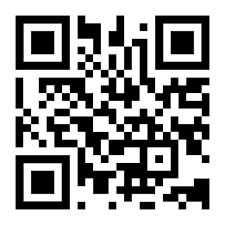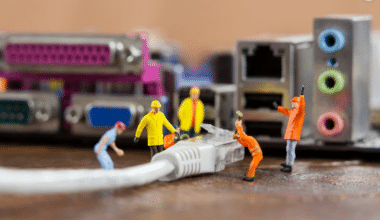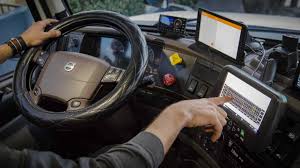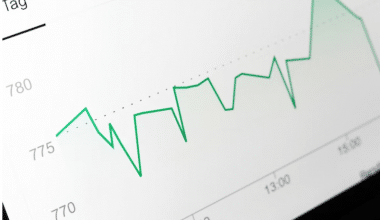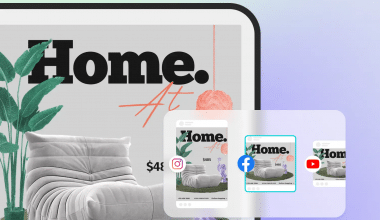Nearly immediately, QR codes started to appear everywhere, from cereal boxes to billboards to even employee uniforms. The 94% increase in QR code engagements between 2018 and 2020 shows that QR codes are making a huge comeback in our new touch-free society. Join me as I walk you through this article to learn everything there is to know about QR codes and how they work.
What is a QR Code?
QR codes, which stand for “rapid response,” are data-storing scannable barcodes. They are frequently employed in the marketing industry to reroute customers to landing pages, websites, social media profiles, or discount coupons.
A QR code, for instance, can be printed on the back of a business card to take you to the owner’s LinkedIn page. You might be sent to a landing page by a QR code on a billboard.
How do QR Codes Work?
A QR code functions similarly to store barcodes. Each QR code is made up of black squares and dots that stand in for various kinds of data. The barcode’s distinctive pattern turns into data that can be read by humans when it is scanned. This transaction takes place instantly.
Although most people now scan QR codes with smartphones, users must have a QR reader or scanner to get the information. There are many free apps for QR scanning, such NeoReader and QuickMark Barcode Scanner, in case your phone lacks the capacity.
The QR Code’s History And Its Resurrection in 2020
The first use of the QR code, developed in 1994 by Denso Wave’s chief engineer Masahiro Hara, was to monitor the movement of vehicles and parts along an assembly line.
Despite being created in the mid-1990s, the QR code didn’t really take off until the advent of smartphones. To scan the codes, though, consumers still had to download third-party software. When Apple added a QR reader to its phones in 2017, it was a significant advancement. Other manufacturers soon followed suit.
You probably have a good idea of where I’m headed with this.
The QR code allowed businesses a new method to connect with clients in a suddenly touchless society while the COVID-19 pandemic was in full gear. A number of businesses used them for the first time, including those in hospitality, food, retail, and manufacturing.
How Do QR Codes Work on iPhones?
Although scanning QR codes on an iPhone or iPad is fairly simple, not everyone knows how to do it. In the past two years, QR codes have grown in popularity as the need for contactless transactions has increased due to the epidemic. The camera on your device can read these two-dimensional barcodes, which are frequently employed by stores, websites, and other venues as a means of information storage or communication.
How can I use my iPhone to Read a QR Code?
- . Launch the camera application on your iPad or iPhone.
- . Position the camera so the QR code can be seen clearly.
- . Your device will detect the code and provide a notification to you.
- . Touch the notice to go to the location specified by your QR code.
How to use Your iPhone or iPad to Scan QR Codes
The first step is to launch the camera app on your iPhone or iPad if you wish to use it to scan QR codes. On most devices, this is located in the lower right corner of the home page; however, on iPads, it is on the first page, and if you’ve moved it around, it will be in a different location.
Now, place the QR code in front of the device’s camera. This won’t function unless you have a mobile signal or are connected to Wi-Fi.
How Do QR Codes Work for Contact Tracing?
QR codes work in some many ways you can’t imagine. Your visitors just scan a QR code with their smartphone to enter and complete a brief, secure, smart form, which is quick and easy to use.
We can assist you in keeping track of who has visited your property when, why, and for how long, whether you are in charge of an office building, conference center, café, or restaurant. You may then maintain compliance records across many sites by pushing or pulling the data to your preferred applications, such as Excel or Google Sheets.
What is Contact Tracing?
According to the WHO Global Team at the World Health Organization, contact tracing has become commonplace as a result of the COVID-19 pandemic with the main objective of assisting in the tracking and tracing of people who may have been exposed to a person who has been infected with the novel coronavirus.
What makes Contact Tracing Crucial?
Many steps are made to flatten the curve of infection and ease the burden on healthcare providers in order to retain control during a pandemic. In accordance with national regulations, public businesses must be able to disclose the contact information of anyone entering their facilities in case those individuals may have come into touch with someone who has tested positive for COVID-19. This enables health organizations to get in touch with persons who are in danger and inform them of the proper course of action, such as a 14-day period of self-isolation.
How QR Code is Generated?
A two-dimensional barcode called a “Quick Response Code,” or QR code was created in 1994 by Japanese barcode producer Denso Wave.
Smartphones with native QR code scanning and detection capabilities can read and scan QR codes.
These codes are created by using a QR code generator online, which when scanned displays online data.
Today, businesses, healthcare, education, and advertising all often employ QR codes.
The most widespread usage of QR codes, however, is in the corporate world, particularly in operations and advertising.
Types of QR Codes.
Here are the two types of QR Codes:
#1.Static QR Codes
Static QR codes are cost-free and always present. As this kind of QR code cannot be altered, the information it contains cannot be altered.
Links to social networking sites like Facebook, Instagram, YouTube, and Pinterest as well as email addresses, URLs, SMS, and WIFI passwords can all be linked using this method. Static QR codes have the following three characteristics:
(1) They are one-time use (2) They can only store a certain amount of data (3). The likelihood of compromising the QR code’s quality increases if you generate a static QR code with more data.
The use of it is free.
#2. Dynamic QR Codes
Dynamic QR codes are those that can store more data even after being printed on paper and can have their content changed.
This particular QR code type gives users more access to real-time scan monitoring and scan locations. The following characteristics of dynamic QR codes include, but are not limited to:
- The QR code is multifunctional because it supports multiple URL directories.
- It uses a short dynamic URL to store data online and is editable, allowing you to add or remove URLs even after printing or deploying your QR code.
- Users can view their QR analytics results in thanks to the trackable QR code scans, which also have Google Analytics integration.
- with QR code password protection feature” expiry feature for QR codes,” “email notification feature,” and “Google Tag Manager feature”
- integration with other programs like Zapier and HubSpot
- Bulk solution for QR codes
- Advanced QR solutions and API integration
How to Utilize Each Type of QR Code
We can now move on to discussing how to use QR codes in people’s various fields of interest since we have expanded on the fundamental ideas behind them.
Here are applications for QR codes and how they work;
#1. QR codes for URLs
Websites, printed materials including brochures, flyers, and catalogs, business cards, instruction, and storefront windows are all places where QR codes are used. To create your own URL QR code, simply follow the instructions below.
#2. . QR codes for Videos, such as those on YouTube and Google Drive
You may share links to YouTube and Google Drive videos with your family, friends, classmates, and coworkers by scanning these QR codes.
In this manner, the difficulty of manually typing the video’s title can be automatically replaced by scanning and viewing without any hassle.
When looking for films to share with their peers and employ in skill development, instructors, influencers, company marketers, and students can all benefit from using video QR codes.
With the emergence of the social media dominance game, QR codes are a useful tool for gaining more subscribers and followers. The social media QR codes include Pinterest, Instagram, Twitter, and Facebook.
They won’t have any trouble typing in your social media username in the search bar of the social media sites thanks to the QR code you created for them.
What is the Secret Behind QR Code?
But because of Corona, the QR tag also seems unappealing. Due to its secrecy and unfamiliarity, it came to represent all-pervasive digital control in our society for many individuals.
A machine-readable optical marker for information exchange, the QR code. similar to the more well-known barcode. The blocks in the QR tag serve as a means of storing data.
How Do QR Codes Work for Dummies?
On the box of your breakfast cereal, there can be a QR code with nutritional data. Moreover, it might provide a link to an online timetable or directions to the nearest bus stop. You can put a code on your business card, for instance, to link directly to your online resume. There might be additional references or links to resources, including online videos, in a QR code on a class handout. In essence, a physical object is marked with a QR code. You can obtain specific information or internet resources related to that object after scanning it with your smartphone. It’s a quick and simple way to connect the real world with the virtual world (thus the Q in QR). This Mashable blog post lists several unique and intriguing uses for QR codes.
How are QR Codes Decoded?
Finding out the QR code version we’re looking at should be our initial step. The version essentially only depicts the QR code’s actual size. Divide the number of pixels (or modules) in the QR code by 4, then subtract 17 from that figure. For instance, the size of our tattoo QR code is 25 modules, and since (25-17)/4 = 2, it is a version 2 QR code. Versions 7 through 40, which are very large QR codes, contain a few more functions, but the majority of consumer QR codes are small and straightforward, so you don’t need to worry about that.
The format marker for our QR code will be determined next. We just need one of the two identical format markers that each QR code stores. The format marker is composed of 15 bits: 10 bits for error correction and 5 bits for format information. The data mask and error correction level (2 bits) are stored in the first 5 bits of the format marker. You may find these 5 bits here:
Thus, 01100 is the format information in our case. Nevertheless, before being encoded into the QR code, this number was XORed with 10101. We must therefore flip bits 1, 3, and 5. The format information string we obtain after flipping the bits is 0110010101 = 11001. The error correction level is represented by the first two bits of this value. We can again disregard this.
The most crucial information is contained in the final three bits of the format string, which are 001. This indicates that the QR code’s body has been concealed by the mask number 001. The appearance of each conceivable mask number is listed in the following table:
What are the Dangers of QR Codes?
There is no inherent danger with QR codes. They serve only as a means of data storage. But, viewing URLs recorded in QR codes can also be perilous in a number of ways, just like clicking links in emails can be dangerous.
The website address on the QR code may attempt to fool you into providing your username or password for another website. The URL might direct you to a trustworthy website and induce it to do unfavorable actions, such as granting an attacker access to your account. While a vulnerability on the website you are viewing is necessary for such an attack, such vulnerabilities are widespread on the internet. By tricking another website that you are connected to on the same device, the URL can direct you to a malicious website that performs an unwanted action.
Can Someone Steal a QR Code?
Sure, scammers can steal your personal information via QR codes.
As human eyes cannot read QR codes, scammers have started using them to conceal harmful links.
Can QR Codes Track You?
Yes.
In business processes, tracking QR codes is essential, especially if you use them as a marketing tool because it will influence and contribute to the improvement of your present QR marketing strategy.
It goes without saying that it is a crucial resource for future development! There is a saying that goes, “You can’t improve what you can’t measure!” The same idea holds true for marketing and business.
Every firm needs tracking since it enhances operations and marketing initiatives. This also enables you to assess the general expansion of your organization or firm.
Conclusion
Making your company stand out from the competition is unquestionably a marketing 101 lesson. When implemented properly, QR codes can pique the interest of both current and potential clients. Take advantage of the chance to connect QR codes to special deals or insightful information to convert that interest into a sale. To encourage people to scan, you may even generate and print custom QR code die-cut stickers.
Related Articles
- Paypal Transaction Fees: What are The Transaction and How to Avoid The Unnecessary Fees
- How Paying With Bitcoin Is Beneficial?
- TWITCH AFFILIATE PAYOUT: Meaning, Method And Review
- HOW TWITCH MAKES MONEY: The Business Model
- WHAT IS MEDICAL BILLING AND CODING: Understanding the Meaning, Process and Course
